PSAT/NMSQT Prep 2020 - Princeton Review 2020
Functions
Passport to advanced math
Learning Objectives
After completing this chapter, you will be able to:
· Apply function notation
· Define the domain and range of a function
· Evaluate the output of a function for a given input
· Interpret the graph of a function
· Write a function to describe a rule or data set
105/600 SmartPoints®
How Much Do You Know?
Directions
Try the questions that follow. Show your work so that you can compare your solutions to the ones found in the Check Your Work section immediately after this question set. The “Category” heading in the explanation for each question gives the title of the lesson that covers how to solve it. If you answered the question(s) for a given lesson correctly, and if your scratchwork looks like ours, you may be able to move quickly through that lesson. If you answered incorrectly or used a different approach, you may want to take your time on that lesson.
1. Given that  and
and  , what is the product of f(—5) and g(—5) ?
, what is the product of f(—5) and g(—5) ?
1. −6
2. −2
3. 3
4. 9
2. For the two functions f (x) and g(x), tables of values follow. What is the value of f (g(1)) ?
|
x |
f(x) |
|
−2 |
8 |
|
−1 |
6 |
|
0 |
4 |
|
1 |
2 |
|
x |
g(x) |
|
−1 |
−4 |
|
1 |
0 |
|
2 |
2 |
|
4 |
6 |
1. 0
2. 2
3. 4
4. 6

3. The figure shows the graph of r(x). What is one value of x for which r(x) = 0 ?

|
Game |
Number of Students |
|
1 |
5 |
|
2 |
11 |
|
3 |
21 |
|
4 |
35 |
|
5 |
53 |
|
6 |
75 |
|
7 |
101 |
|
8 |
131 |
4. West Valley High School is encouraging students to wear school colors when they attend the home football games by giving a prize to one of the students who does so. The school finds that, as the prizes get more exciting, participation begins to increase. If j represents the game number and f(j) represents the number of students in school colors at game j, which of the following functions best describes the information in the table?
1. 
2. 
3. 
4. 
5. Scientists are modeling population trends and have noticed that when a certain bacterial population changes, the change is based on a linear function of the amount of time elapsed in hours. When t = 21 hours, the population is 8 colonies, and when t = 35 hours, the population is 10 colonies. Which of the following best describes f (t) ?
1. 
2. 
3. 
4. 
6.
Check Your Work
1. D
Difficulty: Easy
Category: Function Notation
Getting to the Answer: Read carefully to see what the question is asking. You need to find the product (fg) of the results when you evaluate each function at x = −5. You could multiply the two functions together and then evaluate the result, but it’s quicker to evaluate each function and then multiply:
![]()

Now, multiply to get (−9)(−1) = 9, which is (D).
2. C
Difficulty: Easy
Category: Function Notation
Getting to the Answer: This is a composition of functions, so start with the innermost set of parentheses, which is g(1). According to the g(x) table, when x = 1, g(x) = 0. Then, x = 0 becomes the input for f. Now, find f (0); the f(x) table shows this is equal to 4, which is (C).
3. 2 or 5
Difficulty: Easy
Category: Graphs of Functions
Getting to the Answer: The notation r(x) = 0 means that the function is crossing the x-axis (has a y-value of 0), so look for the x-intercepts. The function r(x) intersects the x-axis at x = −2, 2, and 5. Only positive values are allowed in Grid-in questions, so use 2 or 5.
4. D
Difficulty: Easy
Category: Describing Real-Life Situations with Functions
Getting to the Answer: You’re given two variables, j and f, which represent the game number and the number of students wearing school colors, respectively. From the data, you can see the rate of change in the number of students is not constant (not linear), so eliminate (A) and (B). Next, try plugging a point toward the bottom of the table into (C) and (D):
(C): 131 = ![]() × 82 + 7
× 82 + 7
131 = ![]() × 64 + 7
× 64 + 7
131 = 32 + 7
131 ≠ 39
Only (D) is left and is correct. For the record:
(D): 131 = 2 × 82 + 3
131 = 2 × 64 + 3
131 = 128 + 3
131 = 131
(D) is correct.
5. C
Difficulty: Medium
Category: Describing Real-Life Situations with Functions
Getting to the Answer: Because the slopes of all the answer choices are different, you can use the slope formula to determine which choice is correct. The number of colonies depends on the time elapsed, so start by writing the information given as ordered pairs in the form (time, number of colonies). Using the ordered pairs (21, 8) and (35, 10), the slope is  .
.
The only choice with this slope is (C).
Function Notation
Learning Objectives
After this lesson, you will be able to:
· Apply function notation
· Define the domain and range of a function
· Evaluate the output of a function for a given input
To answer a question like this:
1. 
The function h(x) is defined above. Out of the statements below which must be true about h(x) ?
1. h(8) = 2.5
2. The domain of h(x) is all real numbers.
3. h(x) may be positive or negative.
4. I and II only
5. I and III only
6. II and III only
7. I, II, and III
You need to know this:
A function is a rule that generates one unique output for a given input. In function notation, the x-value is the input and the y-value, designated by f(x), is the output. (Note that other letters besides x and f may be used.)
For example, a linear function has the same form as the slope-intercept form of a line; f(x) is equivalent to y:
![]()
In questions that describe real-life situations, the y-intercept will often be the starting point for the function. You can think of it as f(0), or that value of the function where x = 0.
The set of all possible x-values is called the domain of the function, while the set of all possible y-values is called the range.
You need to do this:
· To find f(x) for some value of x, substitute the concrete value in for the variable and do the arithmetic.
· For questions that ask about the domain of a function, check whether any inputs are not allowed, for example because they cause division by zero.
· For questions that ask about a function of a function, e.g., g(f(x)), start on the inside and work your way out.
Explanation:
Check each statement. For the first statement, plug in 8 for x:

So the first statement is true. Eliminate choice (C).
For the second statement, you need to determine the set of all permitted x-values for this function. Note that the function will be undefined at x = 2 (because at x = 2, the denominator would be zero.) Thus, 2 is not a permitted x-value, and the domain is not all real numbers. The second statement is false. Eliminate (A) and (D).
By process of elimination, the answer is (B), and on test day, you would stop here. For the record, here’s why the third statement is true: you’ve already established that h(8) = 2.5, so h(x) can be positive. Try a smaller value for x, such as zero, to get a negative value for h(x):  , so h(x) can be negative as well, which means statement III is true.
, so h(x) can be negative as well, which means statement III is true.
Try on Your Own
Directions
Take as much time as you need on these questions. Work carefully and methodically. There will be an opportunity for timed practice at the end of the chapter.
1. HINT: Are there any answer choices in Q1 you can eliminate right away?
2. If f (x) = x 2 — x for all x ≤ —1 and f (x) = 0 for all x > —1, which of the following could NOT be a value of f (x) ?
1. — 4
2. 0
3. 
4. 2
3. HINT: For Q2, remember that when dealing with nested functions, you should work from the inside out.
4. If  and
and  , where x ≠ −1, what is is g(f(3)) ?
, where x ≠ −1, what is is g(f(3)) ?
1. ![]()
2. 
3. ![]()
4. 
5. HINT: Begin Q3 by solving for h(5) and h(2): plug in 5 for x, then plug in 2 for x.
6. If h(x) = 3x — 1, what is the value of h(5) — h(2) ?
1. 3
2. 8
3. 9
4. 14
|
x |
g(x) |
|
−4 |
0 |
|
−3 |
2 |
|
−2 |
4 |
|
−1 |
6 |
|
0 |
8 |
|
1 |
10 |
|
x |
h(x) |
|
−2 |
−4 |
|
−1 |
2 |
|
0 |
0 |
|
1 |
−2 |
|
2 |
−4 |
7. Several values for the functions g(x) and h(x) are shown in the tables above. What is the value of g(h(—2)) ?
1. —2
2. 0
3. 4
4. 10
8. If f (x) = −4x + 1 and ![]() , what is the value of
, what is the value of  ?
?
1. —11
2. 0
3. 2.5
4. 3
9.
Graphs of Functions
Learning Objective
After this lesson, you will be able to:
· Identify the correct graph of a function
To answer a question like this:
1.
|
x |
h(x) |
|
—3 |
−7 |
|
—2 |
−5 |
|
—1 |
0 |
|
0 |
3 |
|
1 |
11 |
|
2 |
23 |
|
3 |
40 |
2. 
3. The minimum value of function g, whose graph is shown above, is m. Values for the function h are shown in the table above. What is the value of h(m) ?
1. −7
2. −5
3. 0
4. 3
You need to know this:
Interpreting graphs of functions is similar to interpreting graphs of equations. For example:

Say the graph above represents the function f(x) and you’re asked to find the value of x for which f(x) = 6. Because f(x) represents the output value, or range, you can translate this to, “When does the y-value equal 6?” To answer the question, find 6 on the y-axis, then trace over to the function (the line). Read the corresponding x-value: it’s −2, so when f(x) = 6, x must be −2.
The PSAT may sometimes ask about a function’s maximum or minimum. These terms mean the greatest and least value of the function, respectively. This graph of f(x) does not have a maximum or minimum because the arrows on the line indicate that it continues infinitely in both directions. The preceding question, however, does show a function with a maximum.
You need to do this:
· Treat f(x) as the y-coordinate on a graph.
· The maximum and minimum refer to a function’s greatest and least y-coordinates, respectively.
Explanation:
Start by identifying m, which occurs at the lowest point of the function at (0, −3). The “minimum value of function g“ means the least y-value, so m = −3. Next, use the table to find h(−3), which is the y-value for the x-value of −3. According to the table, when x = −3, h(x) = −7. Hence, (A) is correct.
Try on Your Own
Directions
Take as much time as you need on these questions. Work carefully and methodically. There will be an opportunity for timed practice at the end of the chapter.
1. HINT: For Q6, remember that f(x) and g(x) are found on the y-axis on the graphs.

2. In the figure shown above, what is the value of  ?
?
1. −4
2. 6
3. 10
4. 14
3. HINT: For Q7, the x-values determine the domain, while the y-values determine the range.

4. The graph of f(x) is shown above. Which of the following represents the domain and range of the function?
1. Domain: f(x) ≥ 5
Range: all real numbers
2. Domain: f(x) ≤ 5
Range: all real numbers
3. Domain: all real numbers
Range: f(x) ≥ 5
4. Domain: all real numbers
Range: f(x) ≤ 5
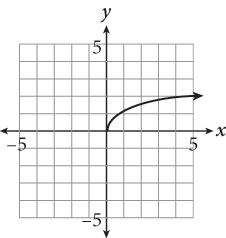
5. The figure shown above represents the function ![]() . Which statement about the function is NOT true?
. Which statement about the function is NOT true?
1. q(0) = 0
2. q(2) = 4
3. The range of q(x) is y ≥ 0.
4. The domain of q(x) is x ≥ 0.

6. In the figure shown above, what is the value of f(3) — g(3) ?
1. —3
2. 0
3. 3
4. 6
7. HINT: Begin by determining the maximum y-value.

8. The function f(x) is graphed in the xy-plane above. If the maximum value of f(x) = z, what is the value of −f(z) ?

9.
Describing Real-Life Situations with Functions
Learning Objective
After this lesson, you will be able to:
· Write a function to describe a rule or data set
To answer a question like this:
|
Type of Meat |
Pounds of Meat per Package |
Profit per Pound, in Dollars |
|
Sausage |
42 |
1.10 |
|
Ground Beef |
30 |
0.38 |
|
Salami |
36 |
0.74 |
|
Bacon |
32 |
0.50 |
|
Ham |
40 |
0.98 |
|
Chicken |
34 |
0.62 |
1. A certain meat distribution company sells several varieties of meat. The company sells the different varieties in differently sized packages. The number of pounds per package and the profit per pound for the different varieties is shown in the table above. The relationship between the number of pounds per package(m) and the profit, in dollars, that the company makes per (p) pound can be represented by a linear function. Which of the following functions correctly represents the relationship?
1. p(m) = 0.09m − 0.41
2. p(m) = 0.08m − 0.82
3. p(m) = 0.07m − 1.11
4. p(m) = 0.06m − 1.42
You need to know this:
Modeling real-life situations using functions is the same as modeling them using equations; the only difference is the function notation and the rule that each input has only one output.
For example, suppose a homeowner wants to determine the cost of installing a certain amount of carpet in her living room. Say that the carpet costs $0.86 per square foot, the installer charges a $29 installation fee, and sales tax on the total cost is 7%. Using your algebra and function knowledge, you can describe this situation in which the cost, c, is a function of square footage, f . The equation would be c = 1.07(0.86f + 29). In function notation, this becomes c(f ) = 1.07(0.86f + 29), where c(f ) is shorthand for “cost as a function of square footage.” The following table summarizes what each piece of the function represents in the scenario.
|
English |
Overall cost |
Square footage |
Material cost |
Installation fee |
Sales tax |
|
Math |
c |
f |
0.86 f |
29 |
1.07 |
You need to do this:
In word problems involving function notation, translate the math equations exactly as you learned in chapter 4 in the Word Problems lesson, but substitute f(x) for y.
Explanation:
Note that the question asks for the relationship between the pounds of meat per package, m, and the profit per pound, p, and that the answer choices all start with p(m). Given the context, this must mean, “profit as a function of the pounds of meat.” All the choices express a linear relationship, so you can’t rule out any of them on that basis.
There are several approaches you could take to find the correct answer. One would be to recognize that all the choices are in the form p(m) = km + b (a variation of the slope-intercept form y = mx + b) and that you can set up a system of linear equations using the data from any two rows of the table to solve for k and b. That approach would look like this:
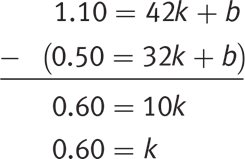
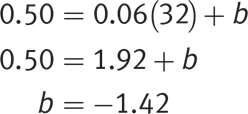
If k = 0.06 and b = −1.42, the correct function is p(m) = 0.06k − 1.42, so (D) is correct.
Another approach would be to use two of the pairs of data points from the table to calculate a slope; for example, using the “sausage” and “bacon” rows would yield  . Because only one answer has a slope of 0.06, you can pick (D).
. Because only one answer has a slope of 0.06, you can pick (D).
One last approach: you could backsolve. Plug any one of the rows of data from the table into all four answer choices. The fourth row, “Bacon,” has the easiest numbers to work with, so use those. You are checking which equation will produce a profit of $0.50 per pound given 32 pounds per package:

Again, (D) is correct.
Try on Your Own
Directions
Take as much time as you need on these questions. Work carefully and methodically. There will be an opportunity for timed practice at the end of the chapter.
1. HINT: Are there any answer choices in Q11 that you can immediately eliminate?
2. A biologist studying the birth rate of a certain fish uses the function b(n) to analyze the fish’s effect on other parts of the ecosystem, where n is the number of eggs laid by the fish over a given period of time. Which of the following lists could represent the domain for the biologist’s function?
1. { . . . —1,500, —1,000, —500, 0, 500, 1,000, 1,500 . . . }
2. {—1,500, —1,000, —500, 0, 500, 1,000, 1,500}
3. {0, 0.25, 0.5, 0.75, 1, 1.25, 1.5 . . . }
4. {0, 500, 1,000, 1,500, 2,000 . . . }
3. A book publisher pays writers a base fee of $2,500 for each book that it publishes, plus 5 cents per word. If one of its writers earned $8,000 on her book last year, how many words, w, did she write for the publisher?
1. 11,000
2. 110,000
3. 155,000
4. 250,000
4. HINT: How does knowing the starting height of the solution help you construct the function in Q13?

5. Tyree is dropping old pennies into a jar that contains a cleaning solution. As he adds more pennies, the height of the solution in the jar changes based on the number of pennies he adds. The figure shows this relationship after 50 pennies have been dropped in the jar. If the height of the solution in the jar was 5 inches (in) before any pennies were added, which of the following linear functions represents the relationship between the number of pennies, p, and the height in inches, h(p), of the solution in the jar?
1. h(p) = 0.7p + 5
2. h(p) = 0.7p + 8.5
3. h(p) = 0.07p + 5
4. h(p) = 0.07p + 8.5
6. HINT: Begin Q14 by calculating the parts per million at both 10 and 20 hours.
![]()
7. Doctors use the function shown above to calculate the concentration, in parts per million, of a certain drug in a patient’s bloodstream after t hours. How many more parts per million of the drug are in the bloodstream after 20 hours than after 10 hours?

8. A teacher is buying supplies for the upcoming school year. Every year, basic classroom supplies such as chalk and paper cost her $500, and she spends an additional $25 per child in her class. The school reimburses her $10 per child for half the children in her class. Which function best describes the amount, in dollars, that the teacher spends per school year on supplies, given that s represents the number of students in the class?
1. ![]()
2. ![]()
3. ![]()
4. ![]()
9.
On Test Day
The PSAT likes to test the modeling of real-life situations. Get comfortable with function notation in these questions. Remember that you can write the equation of a line as y = mx + b or as f(x) = mx + b, where m is the slope and b is the y-intercept. Both mean the same thing. In the formula using function notation, the slope indicates rate of change. Often, in questions asking about real-life situations, the x-variable indicates time. In that case, the y-intercept (i.e., the value of the function at x = 0, or f(0)) indicates the starting point.
1. An environmental agency is working to reduce the amount of toxic waste that a company discards in the ocean. Currently, the company discards 10.8 million pounds of toxic waste annually, and the agency’s goal is to eliminate that amount by collecting the toxic waste and putting it through a process that makes the substance nontoxic. If the agency increases its processing capacity at a constant rate and meets its goal at the end of the 14th year, which of the following linear functions f could the agency use to model the amount of toxic waste (in millions of pounds) being added to the ocean t years into the program?
1. 
2. 
3. 
4. 
The answer and explanation can be found at the end of this chapter.
How Much Have You Learned?
Directions
For testlike practice, give yourself 15 minutes to complete this question set. Be sure to study the explanations, even for questions you got right. They can be found at the end of this chapter.
1. A function is defined by the equation  . For what value of x does f (x) = 5 ?
. For what value of x does f (x) = 5 ?
1. —5
2. 2
3. 9
4. 30
2. If f (x) = —x + 5 and g(x) = x 2, which of the following is NOT in the range of f (g(x)) ?
1. —11
2. 0
3. 1
4. 9

3. The graph of the function f (x) is shown above. What is the domain of the function?
1. y ≥ −4
2. All real numbers
3. y > −4
4. The domain is undefined.
4. Jayesh is a 150-pound, 5-foot-10-inch, 18-year-old male, and he requires 2,048 calories per day to maintain his weight when he doesn’t exercise. When he plays basketball, he burns 231 additional calories per hour. Assuming he wants to maintain his current weight, how many more calories per day does he require if he plays basketball for four hours instead of two hours?
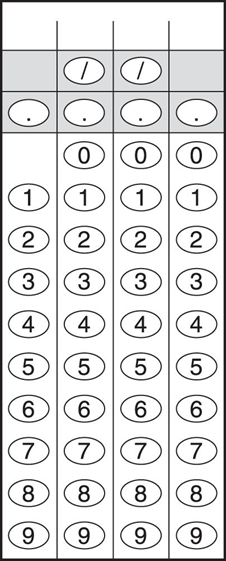
5. Two functions are defined as follows:  and
and  . What is the value of g(f(x)) when x = 2 ?
. What is the value of g(f(x)) when x = 2 ?
1. 6
2. 12
3. 34
4. 36
6. The point (3, 6) lies on the graph of function f in the xy-plane. If  , then what is the value of k ?
, then what is the value of k ?
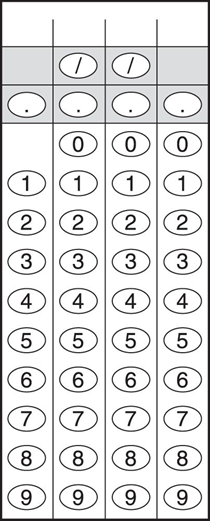
7. A scientist is studying the average annual growth of trees in a newly planted forest. The average height of the trees was 3.6 feet when they were planted, and they have grown an average of 2.4 feet per year since then. The scientist has been studying the growth of the trees for five years. If she uses the function g(y) = h + 2.4(y), where h is the height (in feet) of the trees five years after they were planted and y is the number of years after the fifth year, to determine the expected further growth of these trees from the sixth year onward, which of the following would be included in the range of the scientist’s results?
1. 6
2. 10.8
3. 15.4
4. 18
8. If  and
and  , what is f(g(x)) ?
, what is f(g(x)) ?
1. x + 1
2. 2x + 2
3. 4x + 1
4. 4x + 4

9. The functions f(x) and g(x) are graphed in the xy-plane above. What is the value of f(—2) − g(2) ?
1. —30
2. —20
3. —15
4. 20
10.To install fencing, a builder charges $15 per foot for the first 100 feet plus an additional $12 per foot thereafter. If c represents the total cost of a fence installation, in dollars, and x represents the length of the fence in feet, then which of the following functions best describes the cost of a fence that is more than 100 feet long?
1. ![]()
2. ![]()
3. ![]()
4. ![]()
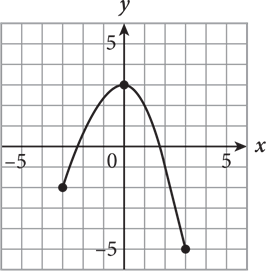
11.The complete graph of the function f(x) in the xy-plane is shown above. What is the domain of f(x) ?
1. All real numbers greater than —5
2. All real numbers between and including —5 and 3
3. All real numbers between and including —3 and 3
4. All real numbers
Reflect
Directions: Take a few minutes to recall what you’ve learned and what you’ve been practicing in this chapter. Consider the following questions, jot down your best answer for each one, and then compare your reflections to the expert responses on the following page. Use your level of confidence to determine what to do next.
What are the domain and range of a function?
What is another way to write the function f(x) = x + 4 ?
In the function above, what does x represent? What does f(x) represent?
What will the above function look like when graphed?
In a function whose x-value represents time, what does the y-intercept represent?
EXPERT RESPONSES
What are the domain and range of a function?
The domain of a function indicates the possible x-values, and the range of a function indicates the possible y-values. For example, in the function f(x) = x2, the domain is all real numbers because any number can be squared, and the range is any number greater than or equal to 0, because x2 can’t be negative.
What is another way to write the function f(x) = x + 4 ?
When you graph the function on the xy-coordinate plane, you can replace f(x) with y. This function is equivalent to y = x + 4.
In the function above, what does x represent? What does f(x) represent?
In this function, x is the input and f(x) is the output.
What will the above function look like when graphed?
The slope of the line is 1 and its y-intercept is 4, so it will move from the lower left to the upper right and cross the y-axis at y = 4.
In a function whose x-value represents time, what does the y-intercept represent?
The y-intercept represents the initial quantity when t = 0. Say a function represents the progress of a machine manufacturing widgets at a rate of 6 widgets per hour. The machine adds the widgets it makes to a growing pile that consisted of 12 widgets when the machine started working. If this function were graphed as a function of time, the y-intercept would be 12—the pile of 12 widgets that were there when the machine started its task.
NEXT STEPS
If you answered most questions correctly in the “How Much Have You Learned?” section, and if your responses to the Reflect questions were similar to those of the PSAT expert, then consider Functions an area of strength and move on to the next chapter. Come back to this topic periodically to prevent yourself from getting rusty.
If you don’t yet feel confident, review those parts of this chapter that you have not yet mastered. All three lessons in this chapter cover question types that are fairly common on the PSAT, and it is to your advantage to have a firm grasp on this material, so go back over it until you feel more confident. Then, try the questions you missed again. As always, be sure to review the explanations closely.
Answers and Explanations
1. A
Difficulty: Easy
Getting to the Answer: You’re looking for a value that is NOT possible for f(x). You’re told f (x) = 0 for all x > −1, so you can eliminate (B) right away. The other part of the function gives f (x) = x 2 − x for all x ≤ −1. Plugging any negative number less than or equal to −1 into this part of the function gives a negative number squared minus the original negative number, which will always be positive. For example, f (−3) = (−3)2 − (−3) = 9 + 3 = 12. Therefore, the range of f (x) will always be greater than or equal to 0. This eliminates (C) and (D), leaving (A) as the correct answer.
2. A
Difficulty: Easy
Getting to the Answer: Make sure you compute the functions in this composition in the correct order. Start with the innermost set of parentheses as you would with any composition of functions. Substitute 3 for x in f(x): ![]() . Next, take the output of f(3) and use it as the input for g(x):
. Next, take the output of f(3) and use it as the input for g(x):  . This matches (A).
. This matches (A).
3. C
Difficulty: Easy
Getting to the Answer: Substitute 5 and then 2 for x in the function and find the difference in the results.
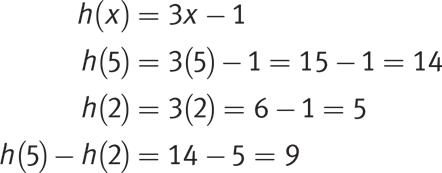
Choice (C) is correct. Caution—this is not the same as subtracting 5 − 2 and then substituting 3 into the function.
4. B
Difficulty: Medium
Strategic Advice: The notation (g(h(x)) can be read “g of h of x.” It means that when x is substituted into h(x), the output becomes the input for g(x).
Getting to the Answer: Start with the innermost function. Use the h(x) table to find h(−2); when x = −2, the output h(x) = −4. Use −4 as the input for g(x) to find g(−4) from the g(x) table. When x = −4, the output g(x) = 0. Choice (B) is correct.
5. A
Difficulty: Hard
Getting to the Answer: The notation f (g(x)) means: find g(x), then substitute the result into f (x). Substitute ![]() for x in g(x) and simplify:
for x in g(x) and simplify:

Next, substitute the result into f (x):
![]()
Therefore,  , so (A) is correct.
, so (A) is correct.
1. D
Difficulty: Easy
Getting to the Answer: Begin by finding f (0). When x = 0 on the graph of function f, y = 4. Therefore, f (0) = 4. Now, repeat for  . When x =
. When x = ![]() on function g, y = 10; thus, g(
on function g, y = 10; thus, g(![]() ) = 10. You’re asked for the sum of f (0) and
) = 10. You’re asked for the sum of f (0) and  , so substitute the appropriate numbers to get 4 + 10 = 14, which is (D).
, so substitute the appropriate numbers to get 4 + 10 = 14, which is (D).
2. D
Difficulty: Easy
Getting to the Answer: To determine the domain, look at the x-values. To determine the range, look at the y-values. For the domain, the graph is continuous and has arrows on both sides, so the domain is all real numbers. This means you can eliminate choices (A) and (B). For the range, the function’s maximum is located at (0, 5), which means the highest possible value of f(x) is 5. The graph is continuous and opens downward, so the range of the function is f(x) ≤ 5, making (D) correct.
3. B
Difficulty: Medium
Getting to the Answer: Compare each answer choice, one at a time, to the graph. Be careful—you’re looking for the statement that is NOT true, so cross out true statements as you go. The statement in (A) is true (and therefore not correct) because at x = 0, y is also 0. For (B), when x = 2, q(x), or y, is somewhere between 1 and 2, not equal to 4, so this statement is NOT true, making (B) the correct answer. For the record, the statements in (C) and (D) are both true because the x-values (domain) and y-values (range) are all greater than or equal to 0.
4. A
Difficulty: Medium
Getting to the Answer: Graphically, the notation f(3) means the y-value when x = 3. It may help to draw dots on the graph. Find x = 3 on the x-axis, then mark each function at this x-value on the graph as shown here:

Now, read the y-coordinates from the graph, paying close attention to which function is which, and subtract: f(3) = −2 and g(3) = 1, so f (3) − g(3) = −2 − 1 = −3. (A) is correct.
5. 2
Difficulty: Hard
Getting to the Answer: First, find the maximum value, which means the highest y-value. The maximum value occurs at the point (0, 3) so 3 is the maximum value. Find f(3) by locating the y-value when x = 3. The point (3, −2) means that f(3) = −2. Remember that the questions asks for the value of −f(z) = −f(3) = −(−2) = 2. Grid in 2.
1. D
Difficulty: Easy
Getting to the Answer: The domain of a function represents the possible input values. In this function, the input values are represented by n, which is the number of eggs laid by the fish over a given period of time. Because there cannot be a negative number of eggs laid or a fraction of an egg laid, the list in (D) is the only one that could represent the function’s domain.
2. B
Difficulty: Easy
Getting to the Answer: First, figure out the function that will show you how the magazine publisher pays its writers. The writers earn $2,500 plus $0.05 per word. So the function for earnings, E, is: E(w) = $2,500 + $0.05(w).
Plug in what you know and solve for what you don’t. The writer made $8,000 for writing one book, so $8,000 = $2,500 + .05(w). Solve for w:
$8,000 = $2,500 + $0.05(w)
$5,500 = $0.05(w)
w = 110,000
So to earn $8,000, the writer wrote 110,000 words for the publishing company. That matches (B).
3. C
Difficulty: Medium
Strategic Advice: The question tells you that the function is linear, which means you need to know the slope (rate of change in the height of the solution) and the y-intercept (height of the solution when there are 0 pennies) to pick the correct function.
Getting to the Answer: You already know the height of the solution when there are 0 pennies—it’s 5 inches. This means you can eliminate (B) and (D). To determine the rate of change in the height of the solution, write what you know as ordered pairs, and then use the slope formula:
At 0 pennies, the height is 5 inches → (0, 5).
At 50 pennies, the height is 8.5 inches → (50, 8.5).
The rate of change in the height of the solution is  . This means the correct function is h(p) = 0.07p + 5, which is (C).
. This means the correct function is h(p) = 0.07p + 5, which is (C).
4. 5
Difficulty: Medium
Getting to the Answer: Evaluate the function at t = 20 and at t = 10, then subtract the results. Make sure you follow the correct order of operations as you simplify:
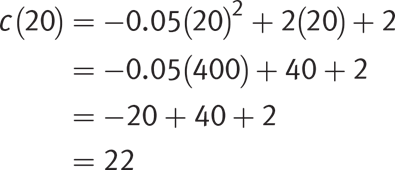
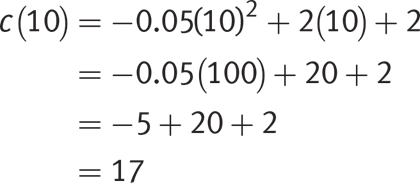
The question asks how many more parts per million are in a patient’s bloodstream after 20 hours than after 10 hours, so subtract 22 − 17 = 5. Grid in 5.
5. A
Difficulty: Medium
Getting to the Answer: The teacher spends $500 plus $25 per child, or 500 + 25s. But she is reimbursed $10 for half of the children in the class, so subtract 10(0.5)(s) to give 500 + 25s − 5s = 500 + 20s. The correct function is f(s) = 500 + 20s, which matches (A).
1. B
Difficulty: Medium
Category: Describing Real-Life Situations with Functions
Strategic Advice: When modeling a real-life situation with a linear function, the starting point in the description is the y-intercept of the equation and the rate of change is the slope. Eliminate choices as you go; you may find that you are able to answer the question after only one or two steps. Never do more math than necessary to answer the question.
Getting to the Answer: In this question, the agency is reducing the amount of toxic waste disposed annually, so the slope must be negative. Eliminate (C) and (D) because their positive slopes indicate an increasing function.
The starting point, or y-intercept, is the amount of toxic waste the company is now discarding, or 10.8 million pounds. Unfortunately, this value is the same in (A) and (B), so you'll need to calculate the value of the slope more precisely.
The agency wants to eliminate all toxic waste produced in a year by the end of 14 years, so to find the amount of reduction per year, divide 10.8 by 14.
The value  does not appear in the choices, and the slopes in the choices do not have decimal points, so multiply the fraction by 1 in the form of
does not appear in the choices, and the slopes in the choices do not have decimal points, so multiply the fraction by 1 in the form of ![]() and reduce until you see a value that matches an answer choice. So,
and reduce until you see a value that matches an answer choice. So,  , so (B) is correct.
, so (B) is correct.
1. D
Difficulty: Medium
Category: Function Notation
Getting to the Answer: The question says that the value of f (x) = 5 and asks for the value of x that produces this result. This means you are solving for x, not substituting for x. Set the function equal to 5, and solve using inverse operations:
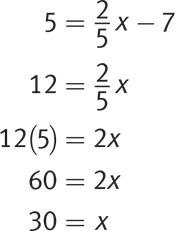
Thus, (D) is correct.
2. D
Difficulty: Hard
Category: Function Notation
Getting to the Answer: When dealing with a composition (or nested functions), the range of the inner function becomes the domain of the outer function, which in turn produces the range of the composition. In the composition f (g(x)), the function g(x) = x 2 is the inner function. Every value of x, when substituted into this function, will result in a nonnegative value (because the value of x is squared). This means the smallest possible range value of g(x) is 0. Now, look at f (x): substituting large positive values of x in the function will result in large negative numbers. Consequently, substituting the smallest value from the range of g, which is 0, results in the largest range value for the composition, which is −0 + 5 = 5. Therefore, the range of f(g(x)) is ≤ 5. The only answer choice that does not fall within this range is (D).
3. B
Difficulty: Easy
Category: Graphs of Functions
Getting to the Answer: The domain of a function is all possible x-values. In this case, the arrows indicate the graph is going to continue infinitely in both directions, so every x-value is possible, meaning the domain of the function is all real numbers. (B) is correct.
Note that if you forgot whether it is the x- or y-values that gives you the domain, (A) would have been a tempting choice. (A) actually gives the correct range of the function, which is determined by all possible y-values.
4. 462
Difficulty: Medium
Category: Describing Real-Life Situations with Functions
Getting to the Answer: Questions sometimes include extra information that you don’t need to get the answer. For this question, all you need to consider is the difference in calories between playing basketball for 4 hours and playing basketball for 2 hours. Since that activity burns 231 calories per hour, the difference is 2 × 231 = 462.Grid in 462.
5. C
Difficulty: Easy
Category: Function Notation
Getting to the Answer: The trick to questions like this one is to make sure you’re careful with the order of the nested functions. Work from the inside out. In this case, you’re asked for g of f so start with f(x), plugging in the given value for x:  .
.
Now, move to the outer function:
![]() . This matches (C).
. This matches (C).
Note that if you had worked your nested functions in the wrong order—as you would if you’d been asked for f(g(x))—your final result would have been 6, which matches (A). Always double-check that you’re working your way through nested functions in the correct order, from the inside to the outside.
6. 81
Difficulty: Easy
Category: Function Notation
Getting to the Answer: Remember that f(x) means y. Substitute 3 for x and 6 for f(x) to find k:
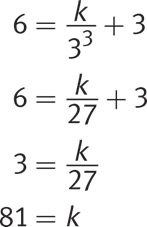
Grid in 81.
7. D
Difficulty: Medium
Category: Describing Real-Life Situations with Functions
Getting to the Answer: The range of the function is all of the possible g(y) values. So this question asks you to determine which numbers are too small to be part of the range of the scientist’s data.
First, calculate how tall the trees would be when the scientist begins to use her function: h = 3.6 + 2.4(5) = 15.6 feet. Having solved for h, the function can now be written as g(y) = 15.6 + 2.4y, where y is greater than or equal to 0, and the range will be any value greater than or equal to 15.6. Only (D) is larger than 15.6, so it is correct.
8. A
Difficulty: Hard
Category: Function Notation
Getting to the Answer: To find f(g(x)), replace the variable in f(x) with g(x), or 2x − 1:
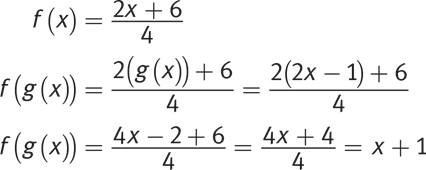
Thus, (A) is correct.
9. B
Difficulty: Medium
Category: Graphs of Functions
Getting to the Answer: Start by figuring out the y-values needed. On the graph, f(−2) has a value of 5, while g(2) has a value of 25. Therefore, f(−2) − g(2) = 5 − 25 = −20. This matches (B).
10.B
Difficulty: Medium
Category: Describing Real-Life Situations with Functions
Getting to the Answer: The cost for the first 100 feet will be $15(100) = $150. This number will be added to the cost for the remainder of the fence. Eliminate (C) and (D), which subtract the 150 instead of adding it.
Now, consider what happens after the first 100 feet. The remaining length of fencing is the total length, x, minus the first 100 feet, or x − 100. Multiply by 12 to find the cost for this section of the fence: 12(x − 100). The complete function, then, is c(x) = 150 + 12(x − 100). This matches (B).
11.C
Difficulty: Medium
Category: Graphs of Functions
Getting to the Answer: The domain is all the x-values that will yield a value for f(x). From left to right, notice that the graph goes from −3 to 3 and includes the endpoints. Thus, (C) is correct.